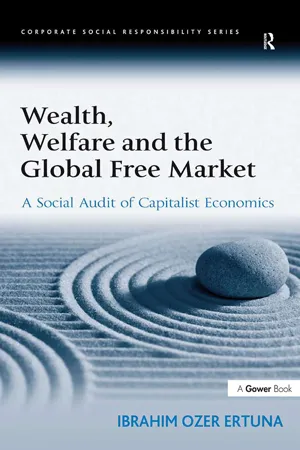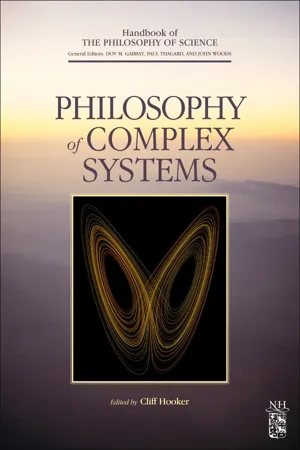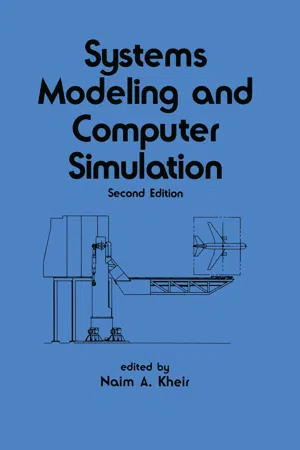Economics
Economic Systems
Economic systems refer to the way societies organize and distribute resources to meet the needs and wants of their citizens. There are various types of economic systems, including traditional, command, market, and mixed economies. Each system has its own set of rules and institutions that determine how goods and services are produced, distributed, and consumed within a society.
Written by Perlego with AI-assistance
Related key terms
Related key terms
1 of 4
Related key terms
1 of 3
6 Key excerpts on "Economic Systems"
- eBook - ePub
Wealth, Welfare and the Global Free Market
A Social Audit of Capitalist Economics
- Ibrahim Ozer Ertuna(Author)
- 2016(Publication Date)
- Gower(Publisher)
Economics studies these institutions, means and rules, and tries to understand how these institutions, means and rules serve the people. Questions relating to production and sharing are not easy ones to answer. Throughout history, economics has searched for answers to the questions “How shall we produce?” and “How shall we share?” The answers provide for a wide range of solutions. Currently, at one end stands the principle “Every one contributes to production according to his means, and consumes according to his needs.” Various collective systems exist to meet this principle, such as the kolkhoz and the kibbutz. At the other end, the principle is that “Every one contributes to production according to his competency which is rewarded with a commensurate income, and consumes according to his income.” The capitalist system follows this second principle. Here we will try to study some of these Economic Systems. What is Economics? Economics is a field that specifies the institutions, the means and the rules for participating in the production of goods and services and sharing the outputs of that production. From a different point of view, we can define economics as the allocation of scarce resources to the areas of production and consumption in order to increase the satisfaction of the people. This point of view emphasizes the fact that the resources we can allocate to production and consumption are limited, and the objective of the allocation system is the satisfaction of the people. Whatever the definition, the answers sought in economic studies do not change: questions such as “How are the goods and services produced?”, “Who owns or should own the factors of production?”, “What should be the method of sharing the goods and services produces?”, and so on - eBook - ePub
Averting Climate Catastrophe Together
Framework for Sustainable Development with a Cooperative and Systemic Approach
- Martin Zapf(Author)
- 2022(Publication Date)
- De Gruyter(Publisher)
Chapter 4 Economic SystemIn this chapter, economics is brought together with systems science. First, general basics about economics are briefly presented before some main features of neoclassical theory are outlined. Subsequently, the view of the economy as a complex adaptive system is described – a research area also known as complexity economics.Since institutional development, together with technological change, significantly influences the performance of economies and the way societies and economies develop over time, this chapter first conveys what is meant by institutions. “Institutions are the rules of the game in a society or, more formally, are the humanly devised constraints that shape human interaction. In consequence they structure incentives in human exchange, whether political, social, or economic” [67 ]. Institutions can be both, formal political (or judicial) as well as economic norms and rules, e.g., constitutions, laws, technical norms, individual contracts, nested in a hierarchy, where each level is more elaborate to change than the lower level. They can also be informal cultural derived norms and rules of behavior, e.g., traditions, routines, customs or conventions [67 ]. Institutions are also an essential basis for market design [68 –70 ]. In general, institutions reduce uncertainties with respect to the behavior of individuals in the process of human interaction and provide an environment that enables cooperation. Crucial to the functioning of institutions are effective mechanisms for enforcing the rules and norms. The institutional framework influences the development of organizations, which in turn influence the institutional framework. Organizations are groups of individuals united by a common purpose to achieve objectives. They include political entities, e.g., political parties, the senate, a city council or a regulatory body; economic entities, e.g., companies, trade unions, family businesses or cooperatives; social entities, e.g., churches, clubs, sports associations; and educational entities, e.g., schools or universities [67 ]. The behavior of people, both within organizations and in the economy, as well as in society as a whole, is also decisively influenced by cultures. Cultures represent an emergent property within groups of people. They can be described as the set of rules of behavior, values, and agreements in a group that individuals consciously or unconsciously follow to shape a living space. They enable orderly collective action by reducing individual behavioral diversity. Cultures also determine the way individuals process and use information and thus contribute to knowledge management [6 , 33 , 67 - eBook - ePub
- Cynthia Metcalf, Rhonda Atkinson, Rhonda Atkinson(Authors)
- 2017(Publication Date)
- Research & Education Association(Publisher)
Economic growth will make more combinations of goods and services feasible but will not end the problem of scarcity. Figure 2.3 Production Possibilities Curve (Economic Growth) COMPETENCY 2.2 Identify how Economic Systems (e.g., market, command, traditional) answer the three basic economic questions. An economic system of a country manages goods and services. All Economic Systems must answer the same basic economic questions: What to produce? How to produce it? For whom to produce? Different Economic Systems answer these questions in different ways. Traditional Economies— Traditional systems usually rely on custom/tradition to determine production and distribution questions. While not static, traditional systems tend to be slow to change and ill-equipped to propel a society into sustained growth. Today many of the poorer third-world countries depend on traditional economies. Command —Command economies rely on a central authority, be it a dictator or democratically constituted government, to make all decisions about the economy. Market —In a pure market system, there is no central authority, and custom plays very little role in this rather competitive market. Buyers and sellers decide what goods and services will be produced. Every consumer makes buying decisions based on his or her own needs, desires, and income. Individual self-interest rules over the good of others. Every producer decides for himself or herself what goods or services to produce, what the prices will be, which resources are used, and what production methods to use. Producers tend to be solely motivated by a desire for profit. Mixed —A mixed economy contains elements from traditional, command, and market economies. Most countries have a form of mixed economy, although the mixture of tradition, command, and market sectors differs greatly. The U.S. economy has traditionally placed great emphasis on the market, although there is a large and active government (command) sector - eBook - ePub
- Dov M. Gabbay, Paul Thagard, John Woods(Authors)
- 2011(Publication Date)
- North Holland(Publisher)
Criticisms of such assumptions, even when made by Herbert Simon, a Nobel Laureate, have gone largely unheeded as economists have tried to create a discipline that has the form of a science, but not the content [ Simon, 1972 ]. Over the past half century, economic theorists have stubbornly held on to their view that economics should be a branch of decision theory that involves optimizing choices along artificially smooth and conveniently specified production and utility functions, subject to constraints. When we depart from this analytically convenient, but illusory, context we do not enter a scientific domain that is very easy to deal with — it is clearly much more difficult terrain than that confronted in physics, chemistry and biology. We are immediately confronted with very significant philosophical and methodological questions: 1. What should the fundamental unit of analysis be in economics — the individual or some collective, networked entity or should this be variable depending on context? The complex systems perspective leads us quickly to the conclusion that a sharp distinction between economics and sociology cannot be maintained, either philosophically or scientifically. 2. How do Economic Systems emerge? The conventional economist's inability to deal with emergence means that an understanding of the actual process of economic evolution and the associated growth trajectory is not possible. From a complex systems perspective, emergence can be predictable in the presence of appropriate energy sources and a cognitive capacity to acquire and apply knowledge in creative ways. 3. If we cannot use conventional mathematics how do we proceed analytically? Economic evolution involves constantly changing network structures. Sometimes this happens in a slow and steady way while, at other times, it is abrupt and destabilizing. So, economic science has to be done in a fundamentally different way to the conventional approach - eBook - ePub
- Naim Kheir(Author)
- 2018(Publication Date)
- CRC Press(Publisher)
17Economic SystemsLawrence W. Taylor Jr. † Investment Analysis Company, Williamsburg, Virginia17.1 Introduction
National economies are dynamic in that economic conditions change with time and are affected by unexpected shocks and governmental controls. Although the economic principles that govern their dynamics are not as precise as for physical systems, it is nevertheless possible to model and simulate national economies with reasonable accuracy. As with the physical systems discussed in Chaps. 1 and 2 , a set of ordinary differential equations is used to depict the complex interactions of the economic variables.Although it is possible to simulate almost any aspect of the national economy, some difficulties must be overcome. First, the bulk of economics literature concentrates on illustrative notions that address the effects of changes in individual variables. Seldom are there quantitative relationships, and rarer still are there dynamic relationships suitable for simulation. To make matters worse, economic views are often inconsistent and controversial. Second, the economic database is vast and diverse, but limited in significant ways. The data are periodic, usually monthly or quarterly, noisy, and often biased. Because of the tendency of economic conditions to fluctuate periodically, as in the 4 year business cycle, the frequency content of economic variables is concentrated at 1.57 rad/ year. This causes a strong correlation among economic variables, which presents an obstacle in differentiating between cause and effect. The complexity of a complete economic system is truly awesome. It is the task of the econometrician to model the particular aspect of the economy of interest with minimum complexity.The objective of this chapter is to develop macroeconometric models of the United States and employ them for forecasting and for studying policies for regulating inflation and unemployment. To achieve this objective, (1) it is necessary to model the pertinent economic variables, including those affected directly by governmental control; (2) it is also necessary to estimate the model parameters from historical data; (3) finally, it is possible to simulate monetary policy in controlling inflation and to simulate future economic conditions. - eBook - ePub
- Steven Rosefielde(Author)
- 2013(Publication Date)
- WSPC(Publisher)
9 If it is not, others are in control. Every system has its own sovereign(s) [dominant policymaker(s) /terms-setter(s)] who strives to preserve power and orchestrate the nation’s utility seeking, behind an idealistic facade.Economic Systems can be divided broadly into two categories: coercive and voluntary. Coercive systems thwart self-discovery, enlightenment, free utility seeking and the empowerment of individuals, minorities, majorities and rivals. The coercers may be individuals (authoritarians), groups (classes, castes, parties, etc.), religions (theocracies), and even cultures (Confucianism, communalism, etc.)Voluntary systems foster self-discovery, enlightenment, free utility seeking and the harmonious empowerment of individuals, minorities, majorities and rivals. This paradigm is epitomized by democracies committed to free enterprise and the protection of minority rights, but all democracies are not the same.10 Social democracies like the EuropeanUnion infringe individual property rights in order to transfer wealth to social groups its sovereigns consider deserving.11American democratic sovereigns are elected on the principle of restricted majority rule, where all minority rights are constitutionally protected. EU democracy also upholds the concept of electoral majority rule, but with exceedingly weak property rights protections enabling officials to transfer more of the nation’s purchasing power from individual consumers to the state than in America.Economic Systems are heterogeneous, and the criteria for appraising them are correspondingly diverse. Systems analysis requires an open mind, and careful scrutiny of outcomes from internal and external perspectives to appreciate various economies’ strengths and weaknesses.This liberal approach is particularly important in Asia where all systems have some coercive aspects. North Korea’s communist regime is the most despotic. Communist China, Laos, Vietnam and Cambodia are more permissive in the household and civic spheres, but remain politically repressive, while Japan, South Korea, Taiwan, and Thailand are maturing democracies with elements of market competition, and civil liberties. The restrictive dimension of Japan’s, South Korea’s, Taiwan’s, and Thailand’s systems judged from the standpoint of the American democratic free enterprise model mostly reflect consensus cultural values (isms) and are voluntary from this perspective. They are approved by the vast majority even though they violate individualist neoclassical textbook principles of economic efficiency and national welfare maximizing. The restrictive dimensions of China’s, Laos’s, Vietnam’s and Cambodia’s regimes by contrast are involuntary because they are imposed by their communist parties.
Index pages curate the most relevant extracts from our library of academic textbooks. They’ve been created using an in-house natural language model (NLM), each adding context and meaning to key research topics.
Explore more topic indexes
Explore more topic indexes
1 of 6
Explore more topic indexes
1 of 4





